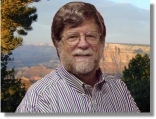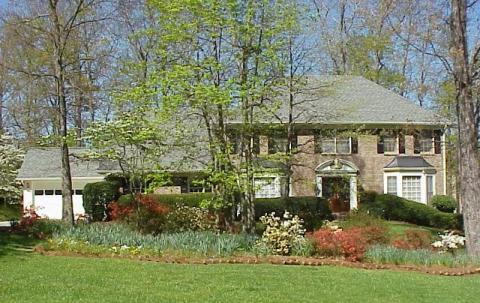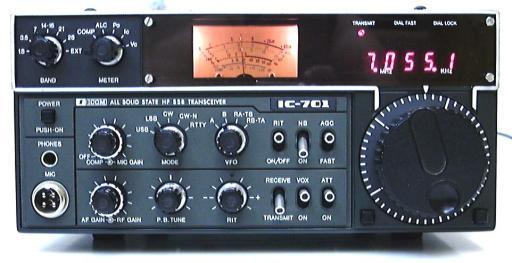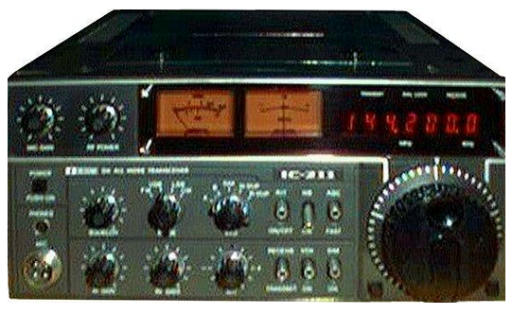  Chaz Cone
Ham Radio and me in the '80s
We found a new home under construction, this time in Fulton County in Sandy Springs, GA (a northern suburb of Atlanta):

This time I felt that I needed to go up only 70' since the lot was nice and high. The tower was installed through the deck and bracketed to the house. The guy wires were nowhere near the driveway this time! Something happend to the Classic 33 antenna on the way back from Boca so I upgraded to the Classic 36.
To replace it, I bought a new, solid-state Icom 701 transceiver. This was a unique package for a radio. Usually they are wider than they are deep; the Icom design was narrow and deep -- but not too deep:

 Looks a lot like the 701, doesn't it?
1981 - 1985And then, in August, came the event that would forever change my life and take me off the air (for all practical purposes) for twenty years. IBM announced the IBM PC. That same day, Ron Lorber called me and said the following:"Chaz, no orthodontist is going to want a program for his office that runs on a Radio Shack TRS-80 when the IBM PC exists." That day, Jim and I stopped development on the TRS-80. I ordered my first PC on the employee purchase plan and we started learning the PC. The original machine came with a single 360KB diskette drive. Just something as simple as copying a diskette involved a dozen diskette changes to accomplish. And there was no hard disk (yet). I have a clear memory of driving across Atlanta to buy a second 360KB floppy drive -- for $500! As we experimented with the PC, it became clear that interpretive Basic was just too slow to accomplish anything of value. Jim and I recruited another IBMer, Gerry Howe, to write some assembly language code to sit under our Basic application code to get good speed. Gerry was/is brilliant. The next step was to get a hard disk. Because of the PC's open architecture, companies sprang up by the score offering accessories and modifications. A small company from Silicon Valley, Davong Systems, announced at the West Coast Computer Faire a 5MB hard disk for (only) $2,000. We couldn't imagine a device that robust: 5MB!!!! That's more disk space than anyone would EVER need! We ordered one; it was the size of a shoebox! We decided to call the "product" we were developing the Orthodontic Practice Management System (or "OPMS" for short). Development went pretty quickly (considering we all had full-time jobs) after Gerry got the assembly language work done. And it ran fast! Ham Radio? Just dormant now. We installed OPMS in Ron's office in July 1983 without a real thought to whatever might come next. After all, it was just a no-charge lark to see if we could do it. It wasn't long before a colleague came through Ron's office and said "What's that?!? How do I get one?" Ron called to tell me; I called Jim and Gerry and we made up a price on the spot. That orthodontist was Dr.Burch Cameron from Columbus GA and he became OPMS user #2 -- and later, became a ham with the callsign W4WY! And, just like that, we sold a total of sixteen license to OPMS by the end of 1985. Backtrack with me to Thanksgiving 1982. My pal and co-developer of OPMS, Jim and his wife Norma came to the house and Jim (not usually prone to displays of joy) had a big smile on his face. Seems in his job as a high-up executive with ADP, he was doing Mergers and Acquisition work. One of the projects ended with a "no deal" but he was impressed with the principal of the acquisition prospect, Restaurant Systems, Inc. That principal, Mike Bodnar, offered Jim a job, luring him away from a major position at ADP. Restaurant Systems owned 36 Wendy's and had developed a program for the IBM PC to help fast-food restaurants manage their food and labor costs. Food and labor are the key elements to profitability in fast-food. Mike and his long-time friend Jim Clutter had taken this program as far as they could without professional management. He thought Jim was the guy to take it forward to other Wendy's franchisees and other fast-food chains. On that Thanksgiving, Jim told me about what he was doing. I was surprised since his job at ADP was a big one and well-paying. His new job was president of the software division of Restaurant Systems; that division was separately incorporated as Restaurant Systems Technology, Inc. (RST) A few days later he called me and said he wanted me to quit IBM and join him as his VP of Sales and Marketing. I thought he was nuts. But, since he was a good friend and knew what I was earning, he made me an offer I couldn't refuse. When I went to my boss and explained that I was resigning to do this, he told me that if I turned it down, to tell Jim about him! So, 22½ years after joining IBM, I resigned to go work with Jim. As part of the negotiation with Restaurant Systems, Jim and I were given time and approval to continue to develop OPMS. The Restaurant Systems plan was to spin off RST in two years and we'd all be rich. Yeah. Eighteen months into that two-year plan, Wendy's corporate decided to buy Restaurant Systems. They wanted those 36 very profitable stores back. This sort of thing happens all the time. Corporate wants to own all the stores, no franchisees. No! They want to own no stores, only franchisees. No! They want... At any rate, Wendy's didn't want the software company. Jim had decided to jump to another company, Mediphis as their president. I decided to try to buy Restaurant Systems Technology, Inc. myself. You learn a lot trying to make that kind of a move. I'd arranged the financing and submitted what I believe was the high bid -- and, somehow, the company was sold to Jim Clutter (Mike Bodnar's long-time friend). So here I was, late in 1985, with no job for the first time in my working life. I had three choices as I saw it:
I didn't want to go back to IBM even if I could (and I was told I was re-hirable). The company had changed so much in the 20+ years I was there, and not to the better in my opinion. I went on three VP Sales interviews and got three offers. But in my heart I knew I wasn't that guy on stage with the striped blazer, boater and cane any more. I'm a developer, dammit! And Ham Radio just wasn't available to me in my time line .. as I'm sure you can see.
1986-1989By this time, we had sixteen OPMS users. I called them the "OPMS Sweet Sixteen". I reasoned that if we could get sixteen clients working part time, we could do much better full-time.And that came to pass. I hired good people, listened to the clients' needs, made good changes to the programs, spent money on marketing and grew the business. Read on for my '90s Ham Radio experiences..
|